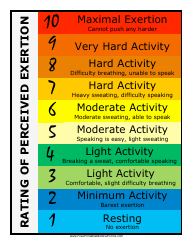Perceived Exertion Scale Chart (Borg Rating)
The Perceived Exertion Scale Chart, also known as the Borg Rating of Perceived Exertion, is a tool used to measure and communicate an individual's exertion level during physical activity. It helps individuals rate their perceived exertion on a scale from 6 to 20, with 6 being no exertion and 20 being maximal exertion. This scale is commonly used in fitness, sports, and medical settings to monitor and adjust exercise intensity.
The Perceived Exertion Scale Chart (Borg Rating) is not typically filed by a specific party. It is a tool used to subjectively measure perceived exertion during physical activity.
FAQ
Q: What is the Perceived Exertion Scale Chart?
A: The Perceived Exertion Scale Chart, also known as the Borg Rating, is a tool used to measure the intensity of exercise.
Q: How does the Perceived Exertion Scale work?
A: The Perceived Exertion Scale is a numerical scale from 6 to 20, with corresponding descriptions of exertion levels. Individuals rate their perceived exertion based on how hard they feel they are working during exercise.
Q: What are the different levels on the Perceived Exertion Scale?
A: The Perceived Exertion Scale ranges from 6 (no exertion at all) to 20 (maximal exertion). Each level has a description to help individuals assess their exertion level.
Q: Why is the Perceived Exertion Scale important?
A: The Perceived Exertion Scale helps individuals and trainers to monitor and adjust exercise intensity to ensure safety and effectiveness of workouts.
Q: How can the Perceived Exertion Scale be used during exercise?
A: During exercise, individuals can use the Perceived Exertion Scale to self-assess and modify their exercise intensity. They can aim to exercise at a desired level of exertion based on their fitness goals and overall health.








